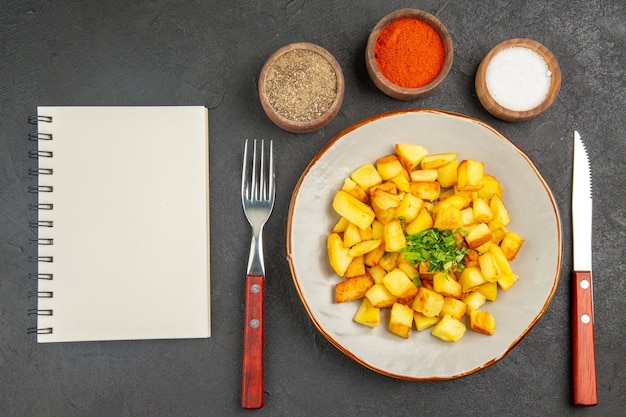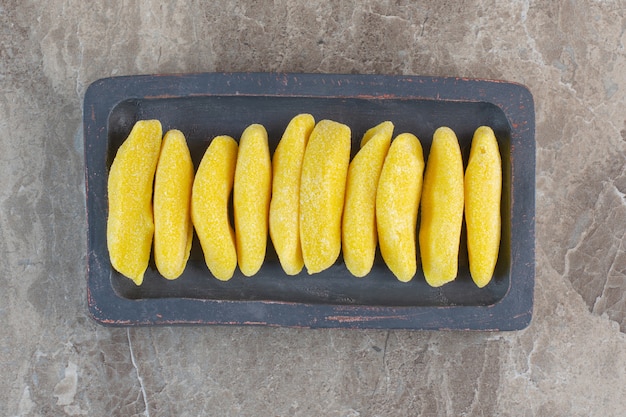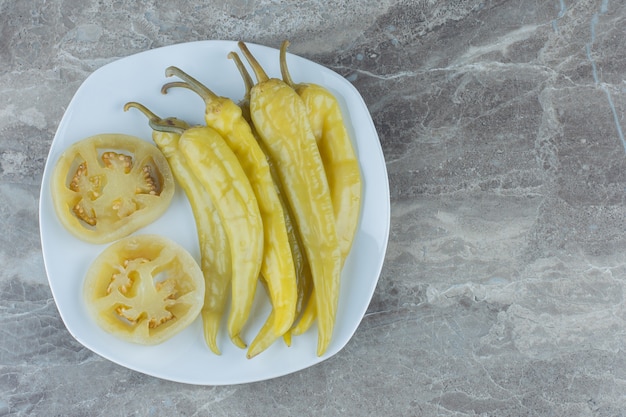The mere mention of "fried plantains" sends my tastebuds into a frenzy. I can almost smell the sweet, caramelized aroma wafting from the kitchen, instantly transporting me back to my childhood, where crispy fried plantains were a regular fixture on our dinner table. They weren't just a side dish; they were a flavor explosion, a symphony of textures, a delicious dance between sweet and savory. They were pure, unadulterated joy on a plate.
Now, I'm not claiming to be a master plantain fryer. Trust me, I've had my fair share of mishaps. There have been times when the plantains have ended up soggy and limp, and other times when they’ve been burnt to a crisp. But through trial and error, I've learned a thing or two, and I'm here to share my knowledge with you, fellow plantain lovers. This guide isn't just about frying plantains; it's about a journey of discovery, a celebration of this versatile fruit, and a quest for the ultimate crispy, golden-brown perfection.
(Part 1) Choosing the Right Plantains: The Key to Success

You can't just grab any old bunch of plantains and expect magic to happen. It's like trying to paint a masterpiece with a paintbrush that's been left out in the rain – it just won't work. You need the right tools for the job, and in this case, that means choosing the right plantains.
The Plantain Scale: From Green to Black – Understanding Ripeness
Plantains come in various stages of ripeness, and each stage lends itself to different dishes. For our crispy fried plantains, we're looking for plantains that are slightly green to yellow, a perfect balance between starchy and sweet. This provides the right texture for frying and avoids the overly sweet taste of ripe plantains.
| Stage | Color | Texture | Ideal Use |
|---|---|---|---|
| Green Plantains | Green to dark green | Firm, starchy | Tostones (fried and mashed), chips |
| Slightly Green to Yellow Plantains | Green to yellow, with green streaks | Firm but slightly yielding, balance of starch and sweetness | Frying for sweet and savory dishes |
| Yellow Plantains | Bright yellow | Softer, sweeter | Desserts like "maduros" |
| Brown Plantains | Brown, with black spots | Very soft, extremely sweet | Smoothies, jams |
| Black Plantains | Black, with dark brown spots | Very soft and mushy, sweetest stage | Desserts, baked goods |
Selecting the Perfect Plantain: A Step-by-Step Guide
Now that you understand the plantain scale, let's talk about picking the right ones for frying. Here's what to look for:
- Firmness: Choose plantains that are firm to the touch, with no bruises or soft spots.
- Color: Look for plantains that are bright green to yellow, with a slightly shiny skin. The greener plantains will be firmer and less sweet, while the yellow ones will be sweeter and softer.
- Squeeze Test: Give the plantain a gentle squeeze. It should feel slightly firm, not rock hard. You're looking for that balance of starch and sweetness.
Remember, you're aiming for a plantain that's a bit firmer than a ripe banana but not rock solid. A good rule of thumb is to choose plantains that have just begun to turn yellow, with some green streaks remaining.
(Part 2) Preparing Your Plantains: Mastering the Art of Prepping

You've got your perfect plantains, now it's time to prep them for frying. This might seem like a simple step, but it's crucial for achieving those perfectly crispy, golden-brown results we're aiming for. Here's a breakdown of the preparation process.
1. Wash and Peel: The First Steps to Success
Start by rinsing your plantains thoroughly under running water. This removes any dirt or debris that might be clinging to the skin. Then, use a sharp knife to peel the skin. Be patient, use a firm grip, and go slow. It might take a few tries to get a clean, smooth peel. Remember, patience is key to a good peel! For green plantains, the skin can be tougher, so you might need to use a little extra pressure.
2. Slice and Shape: Unleashing Your Culinary Creativity
Now comes the fun part: slicing! You can slice the plantains into thin rounds, chunky wedges, or even long strips. It all comes down to personal preference. I usually opt for chunky wedges. Here's how I do it: I slice the plantain lengthwise into about 1/2 inch thick pieces, then cut each piece diagonally. This ensures good surface area for frying.
Feeling adventurous? Add a bit of flair to your fried plantains by making decorative cuts on the plantain slices. Think checkerboard patterns, swirl designs, or even simple cross-hatch cuts. This adds visual appeal and makes your fried plantains even more enticing.
3. Soak and Drain: A Simple Trick for Crispier Results
Here's a tip I learned from my grandmother: before frying, soak the plantain slices in a bowl of cold water for about 15 minutes. This helps remove excess starch and prevents the plantains from becoming too oily. It also makes the plantain slices softer, making them easier to fry evenly.
After soaking, drain the plantains well in a colander and pat them dry with a paper towel. This ensures that excess water doesn't splatter when you add them to the hot oil.
(Part 3) The Frying Process: A Culinary Dance of Heat and Flavor

You've prepped your plantains, and now it's time for the magical process of frying. Don't worry, it's not as complicated as it seems. With a bit of practice and a few tips, you'll be creating crispy plantain perfection in no time!
1. Choosing Your Oil: The Foundation of Flavor
The type of oil you use plays a significant role in the texture and flavor of your fried plantains. I prefer to use vegetable oil or canola oil. These oils have a high smoking point, which means they can withstand high temperatures without burning, preventing your plantains from tasting burnt. If you want a hint of coconut flavor, try coconut oil, but be careful as it has a lower smoking point.
2. Heating the Oil: Reaching the Perfect Temperature
Pour enough oil into a heavy-bottomed skillet or wok to reach about 1/2 inch deep. Heat the oil over medium-high heat until it reaches about 350°F (175°C). You can check the temperature using a candy thermometer or by dropping a small piece of plantain into the oil; it should sizzle immediately and rise to the surface. If it doesn't, the oil needs to be heated further.
3. Frying in Batches: Achieving Even Cooking
Never overcrowd the skillet. Fry your plantain slices in batches, allowing them to cook evenly. If you overcrowd the pan, the temperature will drop, and your plantains will end up soggy instead of crispy.
4. The Flip: Timing is Key
When the plantain slices are golden brown and crisp on one side (about 2-3 minutes), use tongs to flip them carefully. Continue frying for another 2-3 minutes until they are golden brown and crispy on the other side. If you find that the plantains are browning too quickly, reduce the heat to medium. If they're not browning fast enough, increase the heat slightly.
5. Drain and Serve: The Final Touches
Once your plantains are cooked to perfection, carefully remove them from the oil using a slotted spoon. Place them on a plate lined with paper towels to drain excess oil. Serve them immediately, hot and crispy, alongside your favourite dishes.
(Part 4) Sweet, Savory, or Both: Mastering the Flavors
Now for the fun part: adding flavors! Fried plantains are wonderfully versatile. You can enjoy them plain, or you can dress them up with a variety of toppings and spices, creating an explosion of flavors.
1. Sweet and Savory: A Classic Combination
You can't go wrong with a classic sprinkle of salt and sugar. This combination brings out the natural sweetness of the plantain while adding a touch of savory goodness. For a more intense flavor, try a pinch of cinnamon or a sprinkle of nutmeg.
2. Spicy Kick: Adding Heat
Add a fiery kick to your fried plantains with a sprinkle of chili powder, cayenne pepper, or paprika. A dash of hot sauce on top also works wonders. If you’re feeling adventurous, try a blend of cumin, coriander, and paprika for a smoky and spicy flavor.
3. Creamy Delights: Luxurious Toppings
Elevate your fried plantains with a drizzle of honey or maple syrup for a sweet and sticky treat. Or, for a decadent touch, top them with a dollop of whipped cream or coconut cream. A sprinkle of chopped nuts or a drizzle of chocolate sauce adds a delightful crunch and extra sweetness.
(Part 5) Beyond the Basics: Exploring Variations
Fried plantains are incredibly versatile. Don't limit yourself to the classic recipe! Let your culinary creativity flow, and explore different variations.
1. Plantain Chips: A Crunchy Snack
Thinly slice green plantains and fry them until crispy for a delicious and satisfying snack. You can season them with salt, pepper, or other spices to create your own unique flavour combinations.
2. Tostones: A Crunchy and Flavorful Side Dish
For a crunchy and flavourful side dish, fry green plantains until slightly cooked. Then, flatten them with a heavy object like a plate or a tostone press. Fry them again until they are golden brown and crispy. Tostones can be enjoyed plain or topped with your favourite toppings, such as cheese, salsa, or guacamole.
3. Maduros: A Sweet Treat
If you prefer a sweet treat, fry ripe yellow plantains until they are soft and caramelized. They are a delightful dessert enjoyed on their own or topped with whipped cream, ice cream, or a sprinkle of cinnamon.
(Part 6) Serving Suggestions: A Culinary Symphony
Crispy fried plantains are a perfect accompaniment to a wide variety of dishes. They are a delicious addition to any meal, from breakfast to dinner.
1. Savory Delights: A Side Dish for Main Courses
Enjoy fried plantains alongside your favourite savoury dishes, such as grilled chicken, fish, or steak. They also go well with stews, curries, and rice dishes.
2. Sweet Indulgence: A Delightful Breakfast or Dessert
Fried plantains are a delicious treat for breakfast or dessert. Serve them with pancakes, waffles, or ice cream. They also make a fantastic topping for smoothies or yogurt.
3. Global Fusion: Adding a Tropical Touch
Fried plantains are a versatile ingredient that can be incorporated into dishes from all over the world. They are a popular ingredient in Caribbean cuisine, African cuisine, and Latin American cuisine. Try them in a Caribbean jerk chicken bowl, an African peanut stew, or a Latin American ropa vieja.
(Part 7) Troubleshooting: Common Mistakes and Solutions
Even the most seasoned cook can make mistakes. But don't fret! If your fried plantains don't turn out quite right, don't throw in the towel. I've learned a few tricks over the years to salvage those less-than-perfect batches.
1. Soggy Plantains: A Lack of Crispness
If your plantains are soggy, it's likely that the oil wasn't hot enough or you fried them for too long at a low temperature. Try frying them for a shorter time at a higher temperature, or draining them for longer on paper towels. Make sure to pat them dry before frying to remove excess moisture.
2. Burnt Plantains: Too Much Heat
Burnt plantains are a sign that the oil was too hot. Reduce the heat and continue frying until they are golden brown and crispy. Keep a close eye on the plantains and adjust the heat accordingly.
3. Unevenly Cooked Plantains: Crowding the Skillet
If your plantains are unevenly cooked, it's possible that you overcrowded the skillet. Fry them in smaller batches to ensure that each piece gets cooked evenly. This allows the oil to maintain a consistent temperature.
4. Raw Plantains: Insufficient cooking time
If your plantains are raw in the center, it means they weren't fried long enough. Fry them for a few more minutes until they are cooked through. Use a toothpick or a knife to check for doneness.
(Part 8) FAQs: Your Fried Plantain Queries Answered
Now, let’s tackle some of the most common questions about frying plantains. I've been there, asked these myself! So don't be shy, I'm here to help.
1. What is the best way to store fried plantains?
For the best results, store fried plantains in an airtight container at room temperature for up to 2 days. You can also refrigerate them for up to 3 days, but they may lose some of their crispness. Reheating them in a preheated oven at 350°F (175°C) for about 5 minutes can help restore some crispness.
2. Can I reheat fried plantains?
Yes! Reheat fried plantains in a preheated oven at 350°F (175°C) for about 5 minutes, or until they are heated through. You can also reheat them in a microwave for about 30 seconds, but they might lose some of their crispness. For best results, try reheating them in a skillet over low heat with a little bit of oil. This will help to re-crisp them.
3. Can I use frozen plantains?
Yes, you can use frozen plantains. Simply thaw them overnight in the refrigerator before frying. However, they may not be as crispy as freshly cooked plantains. The thawing process can sometimes cause them to become mushy, affecting their texture.
4. Can I fry plantains in other oils?
Yes, you can use other oils, such as olive oil, avocado oil, or peanut oil. However, these oils have lower smoking points than vegetable oil or canola oil, so be careful not to burn them. Use a candy thermometer to monitor the temperature.
5. What if I don’t have a candy thermometer?
You can test the temperature of the oil by dropping a small piece of plantain into the oil. If it sizzles immediately and rises to the surface, the oil is ready. If it doesn't sizzle, the oil needs to be heated further. Be careful not to drop the plantain in the oil until it's hot enough, or it could splatter.
(Part 9) A Final Bite: Embracing the Plantain Journey
This isn't just a guide to frying plantains; it's a journey. It's a journey of discovery, a celebration of this humble fruit, and a quest for that perfect crispy, golden-brown perfection. You'll have your mishaps, your moments of frustration, and your moments of triumph. Embrace each one. Because at the end of the day, it's all about the joy of cooking, the satisfaction of creating something delicious, and the pleasure of sharing it with loved ones.
So go forth, my friends, and embrace the plantain journey! Experiment, explore, and most importantly, enjoy! And remember, with a little patience and a whole lot of love, you too can master the art of frying plantains, creating a delicious side dish that will be a hit with everyone.
Everyone is watching

How to Cook Frozen Lobster Tails Perfectly: A Step-by-Step Guide
RecipesLobster. Just the word conjures up images of lavish meals, special occasions, and a taste of luxury. But let's...

Pigs in a Blanket Cooking Time: How Long to Bake for Perfect Results
RecipesAh, pigs in a blanket. Just the name conjures up images of those delightful little parcels of crispy pastry en...

Pork Fillet Cooking Time: How Long to Cook It Perfectly
RecipesPork fillet, or tenderloin as it's sometimes called, is a real favourite in our house. It's so versatile, and...

The Ultimate Guide to Cooking Delicious Frankfurters
RecipesLet's face it, we all love a good frankfurter. It's a classic, simple, and always satisfying. But let's be rea...

Wolf Meat Recipes: A Guide to Cooking Wild Game
RecipesLet's be honest, you don't see wolf meat at your local butcher shop every day. It's a bit of a wild card, but ...
